Introduction
Contents
Legislation
The UK Government is working towards providing a greater proportion of the National Grid ("the grid")'s electricity via renewable energy sources in order to reduce the UK's greenhouse gas emissions from fossil fuel power plants. Under the Climate Change Act signed into law in 2008, the government set out targets to cut greenhouse gas emissions by 80% compared to 1990 levels by 2050.[1]
In Scotland, the government has been considering plans "to meet an equivalent of 100% demand for electricity from renewable energy by 2020".[2]
The European Union also has a directive which legislates that the United Kingdom should increase production of electricity from renewable energy sources from 1.3% in 2005 to 15% by 2020.[3]
The Current Grid
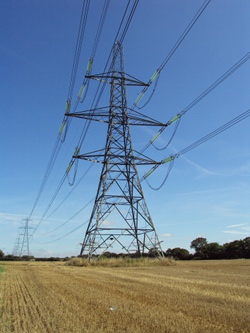
A 400kV power
line, part of the distribution network that forms part of the National
Grid in Great Britain.
Licence: By Benkid77 (Own work) [CC-BY-SA-3.0
or GFDL], via Wikimedia
Commons
At present, electricity is mostly produced from traditional fossil fuel power plants such as coal or nuclear. These usually provide a large, stable source of power that is, to a large extent, not directly influenced by the weather. While some power plants in use in Britain rely on renewable energy sources, they represent only a small proportion of the total generating capacity of the grid and so fluctuations in power production from these plants are reasonably easy to accommodate in the present grid.
Supply and Demand Pattern
Electricity demand in the UK follows a reasonably predictable pattern (as can be seen in the 'Typical Weekly Demand' figure). National Grid controllers forecast demand using a number of measurements such as weather patterns, time of year, day of the week and time of day. Naturally, demand for electricity is greatest in the colder months when households need more heat, and particularly in the daylight hours when offices are lit and heated, and when people use productive equipment such as computers. The whole country's demand throughout the day will tend to fluctuate only gradually, as occasions where additional power is required are offset by other reductions in demand, such as a kettle being switched on in one household as another household's kettle switches off (this is known as the diversity of demand or diversity factor[4]).
-
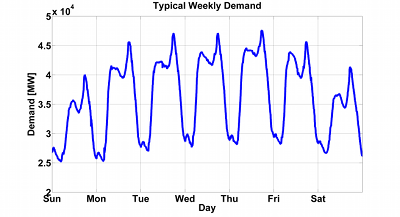
British electricity demand across a week in 2011. At the weekend, the power demand is roughly 15% lower and there is a more gradual morning spike than during the week. Apart from these differences, demand follows the same pattern every day. The shape of the demand across this week, but not necessarily the magnitude, is typical of most weeks.
Data represents week commencing 23rd October 2011.
Data source: National Grid. -
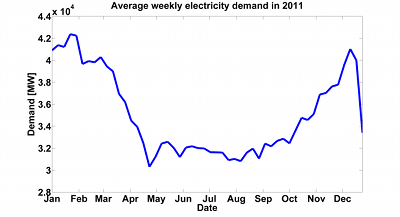
Average 2011 weekly demand in Great Britain. In the winter, demand is at its highest, and in the summer, demand is at its lowest.
Data source: National Grid.
The Future Grid
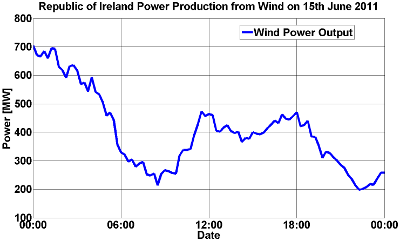
Wind power production in Ireland on 15th June
2011. Power output fluctuations are present throughout the day, on
different scales.
Data source: EirGrid
Future Challenges
Unfortunately, electricity demand does not necessarily follow electricity supply. When the wind stops blowing and the Sun goes down, consumers do not consciously adjust their electricity demand accordingly. The National Grid controllers can predict quite reasonably the electricity demand in the short term future based on temperatures, day of the week and time of the year, among other factors.
Variability of Renewable Energy Sources
The grid controllers cannot predict the weather to a great deal of
precision. This problem is especially compounded with local variations
in wind, clouds and rain. This means that renewable energy sources that
rely on the weather, such as wind and solar, can provide large
fluctuations in their output when the weather is changeable. Across an
entire country, the local variations in weather can reduce the overall
fluctuations in the power being provided from renewable energy sources.
However, still the overall fluctations will be significantly larger in
an electricity grid mainly based on renewable energy sources compared
to an grid mainly based on non-renewable energy sources.
Influence of Renewable Energy Sources on the Grid
The electricity generation fluctuations produced by some renewable energy sources present a problem to the National Grid. While it is in principle possible to build enough renewable energy generation capacity to match the maximum electricity demand, it is impossible to create a renewable energy source which is able to provide its maximum output at all times. Variations in electricity supply from renewable energy sources can result in occasions where there is either too little or too much electricity being produced. Such variations can occur over short periods (such as a quick gust of wind providing additional electricity production from turbines) and over long periods (such as the Gulf Stream moving north during winter, causing a lack of wind across the whole country).
The Solution?
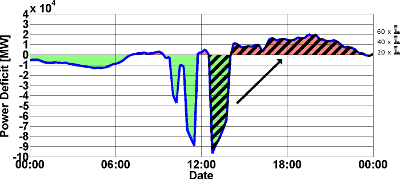
An example of a supply surplus and a supply deficit occurring on the same day. The y-axis shows the deficit between supply and demand, with positive values indicating a lack of required electricity being supplied. There are at first two periods of supply surplus, and later a period of supply deficit. A potential solution to the deficit would be to somehow store the initial surplus for use later on.
A much more elegant solution is to find a way to store surplus energy in times of abundant supply, for use in times when supply is limited.
There exist a few ideas which can help mitigate the fluctuations caused by renewable energy sources. For instance, dynamic demand control is a technique which seeks to limit an appliance's electricity consumption in times when there is limited supply, instead only using electricity when it is plentiful. Some research papers outline techniques involving devices such as fridges or electric cars. To model the effect that such techniques have, though, we need an idea of the frequency and magnitude of the fluctuations the grid based entirely on renewable energy sources would experience.
Our Dataset
The dataset available on this website provides a 1 year long time series of the simualted electricty supply to demand ratio for the year 2025, assuming all electrcity is produced from renewable energy sources. This data set can be used as a benchmark to assess the regularity and size of the fluctuations the future grid might experience, hopefully providing insight into the usefulness of various new technologies, including, among others, dynamic demand control devices.
A description of the dataset and how it was produced can be found on the Data page.
Footnotes
- Parliament of the United Kingdom. Climate Change Act, 2008. Accessed 07/08/12.
- The Scottish Government. 2020 Routemap for Renewable Energy in Scotland. Accessed 07/08/12.
- European Union. Promotion of the use of energy from renewable sources (directive 2009/28/EC), 2009. Accessed 07/08/12.
- Common usage. Mentioned in, for instance, Equipment Load Factors, Use Factors and Diversity Factors As Well as a General Discussion of Energy Audit Procedures, Barney L. Capehart. Accessed 07/08/12.
